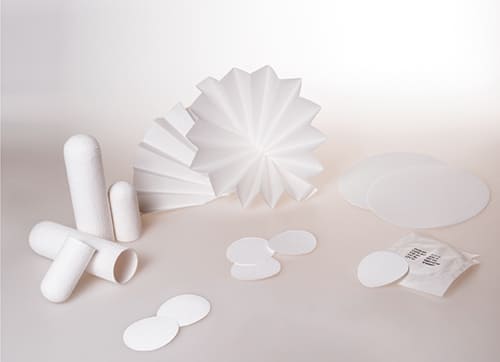10 tips to obtain the maximum performance from your filter paper filtration processes
22 de December de 2023While filtration with filter paper is a basic and apparently simple laboratory process, some variables still need to be considered to obtain the best possible performance and results. It is important to be sure about the handling requirements and properties of the sample.

Tip 1: Type of filter paper
Choose the right paper considering:
- Paper grade: the grade of the paper determines its particle retention capacity and is related to the paper’s pore size and filtration rate.
- Diameter: this depends on the size of the funnel and the volume to be filtered.
- Type of paper: qualitative (for routine separation of the suspended solid) or quantitative (for quantitative analysis of solutions with a lower content of impurities).
- Hardness: determines the filter’s wet strength and stiffness.
- Flat or fluted: flat filter papers are used when the aim is to collect the solid; fluted filters are used when the aim is to collect the filtered liquid, as they have a larger filtration surface.
Tip 2: Chemical compatibility
Be sure to select a paper that is compatible with the sample being filtered, as some compounds can react with the paper and affect the outcome of the process. Hardened filter papers have a higher chemical resistance to acids.
Tip 3: Equipment cleanliness
The funnel and receiving vessel must be cleaned thoroughly before starting. If any of these utensils are contaminated, it can affect the filtration process and the results.
Tip 4: Paper preparation
Precut filter papers, or folded filter papers where applicable, can save time and ensure that the paper fits the funnel correctly. Always try to avoid creasing or displacing the paper during the filtering process.
Tip 5: Sample preparation and prefiltration
Make sure that the sample is prepared properly before filtration. This may involve diluting the sample if it is too concentrated or removing any particles that are too coarse. Prefiltration with a microfibre filter is a good option for retaining larger particles, as it ensures the main filter is not clogged when performing finer filtrations.
Tip 6: Use a wetting agent
Some substances can be hard to filter because of their hydrophobic nature, such as oils, viscous liquids and organic solvents. These samples are best prepared by adding a small amount of a wetting agent, such as a detergent or alcohol, to reduce the surface tension between the liquid and the filter paper, thus facilitating filtration. Make sure the wetting agent does not interfere with the type of sample or filter used.
Tip 7: Apply a vacuum
Applying a vacuum with a pump to generate suction significantly increases the rate of the filtration process. Vacuum filtration should be done using a Büchner funnel and a Kitasato flask. We strongly recommend using a hardened filter paper so that it is not damaged or deformed.
Tip 8: Temperature control
Temperature can influence the filtration rate. Most laboratory filtrations are carried out at room temperature (20–25°C). When working with more viscous liquids, heating them slightly helps reduce their viscosity and therefore increases the filtration rate. Temperature, or its variation during the filtration process, can also cause soluble substances to precipitate out of solution if it cools, thereby clogging the filter. Be careful not to damage the filter.
Tip 9: Filter paper overloading
Avoid overloading filter papers with too much sample, as it can damage or saturate the paper and slow the filtration down.
Tip 10: Laboratory notebook
Record all the data and parameters of the filtration process, including the type of paper used, the volume filtered, the temperature and time elapsed, among others. This information can be used to identify errors and make improvements.
For further information or to enquire about other products or services, please write to helpdesk@scharlab.com.


